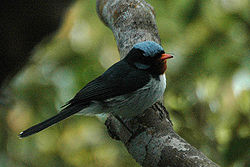Taxonomy
The azure-crested flycatcher was first described in 1875 by ornithologist Edgar Leopold Layard, Administrator of the Government of the Colony of Fiji at the time. [2] Its specific epithet is derived from the Latin azureus 'blue', and capillus 'of the head'. [3] It is also commonly known as the blue-crested broadbill, [4] or the azure-crested flycatcher.
It is a member of a group of birds termed monarch flycatchers. This group is considered either as a subfamily Monarchinae, together with the fantails as part of the drongo family Dicruridae, [5] or as a family Monarchidae in its own right. [6] They are not closely related to their namesakes either, the Old World flycatchers of the family Muscicapidae; early molecular research in the late 1980s and early 1990s revealed the monarchs belong to a large group of mainly Australasian birds known as the Corvida parvorder comprising many tropical and Australian passerines. [7] More recently, the grouping has been refined somewhat as the monarchs have been classified in a 'Core corvine' group with the crows and ravens, shrikes, birds of paradise, fantails, drongos and mudnest builders. [8]
In 2016, two former subspecies of the azure-crested flycatcher were reclassified as a separate species, the chestnut-throated flycatcher. [9]
This page is based on this
Wikipedia article Text is available under the
CC BY-SA 4.0 license; additional terms may apply.
Images, videos and audio are available under their respective licenses.


